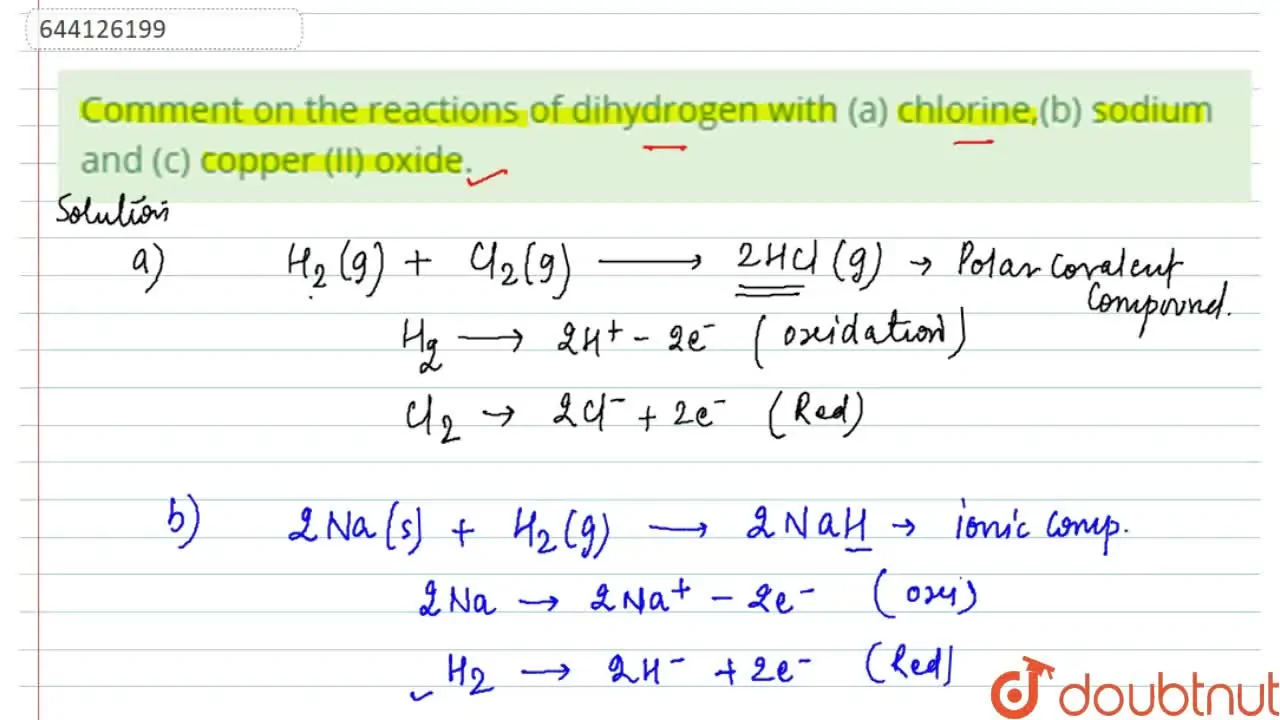Comment on the reactions of dihydrogen with (a) chlorine,(b) sodium and (c) copper (II) oxide.
dihydrogen reduces chlorine into chloride (Clɵ) ion and itself gets oxidised to H⊕ ion by chlorine to form hydrogen chloride. An electron pair is shared between H and Cl leaving to the formation of a covalent molecule.
H2g+Cl2g→2HClgHydrogen chloride
(b) Dihydrogen is reduced by sodium to form NaH. an electron is transfer from Na to H leading to the formation of an ionic compound, Na⊕Hɵ.
red between H and Cl leaving to the formation of a covalent molecule.
H2g+2Na2g→2NaHsSodium hydride
(c) Dihydration reduces copper (II) oxide to copper in zero oxidation state and itself gets oxidised to H2O, which is a covalent molecule.
H2(g)+CuO→Cus+H2O(1)
Related Playlists
- BOOK - CENGAGE CHEMISTRY ENGLISHCHAPTER - HYDROGEN, WATER AND HYDROGEN PEROXIDEEXERCISE - Solved Examples8videos
HYDROGEN, WATER AND HYDROGEN PEROXIDE
- BOOK - CENGAGE CHEMISTRY ENGLISHCHAPTER - HYDROGEN, WATER AND HYDROGEN PEROXIDEEXERCISE - Ex 3.14videos
HYDROGEN, WATER AND HYDROGEN PEROXIDE
- BOOK - CENGAGE CHEMISTRY ENGLISHCHAPTER - GENERAL ORGANIC CHEMISTRYEXERCISE - Analytical and Descriptive1videos
GENERAL ORGANIC CHEMISTRY
- BOOK - CENGAGE CHEMISTRY ENGLISHCHAPTER - IONIC EQUILIBRIUMEXERCISE - Archives Subjective28videos
IONIC EQUILIBRIUM
Similar Questions
Comment on the reaction of dihydrogen with fluorine.
View SolutionWrite the formula of Copper(II) oxide.
View SolutionWrite equation for the reactions of aqueous hydrochloric acid on : copper oxide.
View SolutionGive an equation for reaction of conc HNO3 with (i) carbon
(ii) copper .View SolutionExplain with the help of (i) an ionic equation (ii) electron dot structural diagram (iii) atomic or orbital structural diagram for the formation of the following:
(a) Sodium chloride (b) Calcium oxide (c) Magnesium chloride.View SolutionA compound which liberates reddish brown gas around the anode during electrolysis in its molten state is
(a) Sodium chloride
(b) Copper (II) oxide
(c) Lead (II) bromide
(d) Copper (II) sulphateView SolutionGive balanced equations for the reducing reactions of ammonia with
i] copper [II] oxide ii] lead [II] oxideView SolutionThe main product of the reaction of propane with chlorine at 25∘C in the presence of sunlight is
View SolutionMatch the following
1. Reaction of hydrogen sulphide with chlorine (a) Reduction
2. Splitting of water into hydrogen and oxygen (b) Oxidation
3. Reaction of copper oxide with carbon (c) Electrolysis
4. Formation of hydrogen from water and coke (carbon) (d) Bosch processView SolutionName a gas which reduces hot copper (II) oxide to copper.
View Solution


